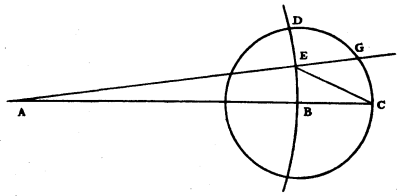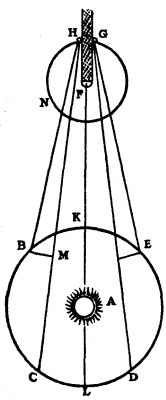Does the spreading of light take time?
Table of Contents
According to this true Philosophy, the sensation of sight is excited only by the impression of some movement of a kind of matter which acts on the nerves at the back of our eyes.
This is another reason for believing that light consists in a movement of the matter which exists between us and the luminous body.
Light spreads on every side at extreme speed, even when it comes from different regions, even from those directly opposite.
- The rays traverse one another without hindrance
This is why when we see a luminous object, its light cannot be due to matter coming from that object.
- It is different from the way an arrow traverses the air.
- Such ab object-based-matter would too greatly impugn these 2 properties of light, especially the second of them.
Thus, light spreads in some other way.
- This way can be exlained by the way Sound spreads in the air
The air is an invisible and impalpable body wherein Sound spreads around the spot where it has been produced, by a movement which is passed on successively from one part of the air to another.
The spreading of this movement takes place equally rapidly on all sides.
- It should form spherical surfaces ever enlarging and which strike our ears.
- Light also comes from the luminous body to our eyes by some movement impressed on the matter which is between the two.
- This is because it cannot be by the transport of a body which passes from one to the other.
If light takes time for its passage, then it means that this movement, impressed on the intervening matter, is successive.
- Consequently it spreads, as Sound does, by spherical surfaces and waves
I call them waves from their resemblance to waves in the water when a stone is thrown into it.
- These manifest as a successive spreading as circles, though these arise from another cause, and are only in a flat surface.
Does the spreading of light take time?
Striking lights on Earth at great distances prove that light takes no sensible time to pass over these distances.
- This time is too small
- It means that the passage of light is extremely rapid.
Descartes thought that it is instantaneous, basing his observations on the Eclipses of the Moon.
- But to me, it is not at all convincing.
I will explain the speed of light differently from Descartes.

Let:
Abe the sunBDa part of the orbit or annual path of the Earth- circle
CD, atC, is the orbit of the Moon ABCa straight line which meets the orbit of the Moon
If light requires 1 hour to traverse the space between the Earth and the Moon, it follows that the Earth having arrived at B, the shadow which it casts, or the interruption of the light, will not yet have arrived at the point C, but will only arrive there 1 hour after.
It will then be 1 hour after, reckoning from the moment when the Earth was at B, that the Moon, arriving at C, will be obscured. But this obscuration or interruption of the light will not reach the Earth till after another hour.
Let us suppose that the Earth in these 2 hours will have arrived at E.
The Earth then, being at E, will see the Eclipsed Moon at C, which it left an hour before.
At the same time will see the sun at A. For it being immovable, as I suppose with Copernicus, and the light moving always in straight lines, it must always appear where it is.
But one has always observed, we are told, that the eclipsed Moon appears at the point of the Ecliptic opposite to the Sun; and yet here it would appear in arrear of that point by an amount equal to the angle GEC, the supplement of AEC.
This, however, is contrary to experience, since the angle GEC would be very sensible, and about 33 degrees.
Our computation is written in the Treatise on the causes of the phenomena of Saturn.
- It says that the distance
BAbetween the Earth and the Sun is about 12,000 diameters of the Earth- It is hence 400 times greater than
BC, the distance of the Moon, which is 30 diameters.
- It is hence 400 times greater than
- It follows that the angle
ECBwill be nearly 400 times greater thanBAE, which is 5 minutes; namely, the path which the earth travels in 2 hours along its orbit- Thus, the angle
BCEwill be nearly 33 degrees.
- Thus, the angle
Likewise, the angle CEG, which is greater by 5 minutes.
But the speed of light in this argument has been assumed such that it takes a time of 1 hour to make the passage from here to the Moon.
If one supposes that for this it requires only one minute of time, then it is manifest that the angle CEG will only be 33 minutes; and if it requires only 10 seconds of time, the angle will be less than six minutes. And then it will not be easy to perceive anything of it in observations of the Eclipse; nor, consequently, will it be permissible to deduce from it that the movement of light is instantaneous.
We are here supposing a strange velocity that would be 100,000 times greater than that of Sound.
Sound travels about 180 Toises in 1 Second, or in about one beat of the pulse. But this supposition should not be impossibile since it is not a question of the transport of a body with so great a speed, but of a successive movement which is passed on from some bodies to others.
It is easy for me to meditate on these things and suppose that the emanation of light is accomplished with time, seeing that in this way all its phenomena can be explained, and that in following the contrary opinion everything is incomprehensible.
Descartes aimed to treat all the subjects of Physics intelligibly.
- He has succeeded in this better than anyone before him.
Even he has said nothing that is not full of difficulties, or even inconceivable, in dealing with Light and its properties.
But that which I employed only as a hypothesis, has recently received great seemingness as an established truth by the ingenious proof of Mr. Römer which I am going here to relate, expecting him himself to give all that is needed for its confirmation.
It is founded as is the preceding argument upon celestial observations, and proves not only that Light takes time for its passage, but also demonstrates how much time it takes, and that its velocity is even at least six times greater than that which I have just stated.
For this he makes use of the Eclipses suffered by the little planets which revolve around Jupiter, and which often enter his shadow: and see what is his reasoning.
Let:
Abe the SunBCDEbe the annual orbit of the EarthFbe JupiterGNbe the orbit of the nearest of his Satellites, for it is this one which is more apt for this investigation than any of the other three, because of the quickness of its revolution.
Let:
Gbe this Satellite entering into the shadow of JupiterHbe the same Satellite emerging from the shadow.

Let us suppose that the Earth is at B some time before the last quadrature, that one has seen the said Satellite emerge from the shadow
If the Earth remains at the same place, after 42-1/2 hours, one would again see a similar emergence. This is because that is the time when:
- it makes the round of its orbit
- it would come again into opposition to the Sun.
If the Earth remained always at B during 30 revolutions of this Satellite, one would see it again emerge from the shadow after 30 times 42-1/2 hours.
But the Earth having been carried along during this time to C, increases its distance from Jupiter. It follows that if Light requires time for its passage the illumination of the little planet will be perceived later at C than it would have been at B, and that there must be added to this time of 30 times 42-1/2 hours that which the Light has required to traverse the space MC, the difference of the spaces CH, BH.
Similarly, at the other quadrature when the earth has come to E from D while approaching toward Jupiter, the immersions of the Satellite ought to be observed at E earlier than they would have been seen if the Earth had remained at D.
Now in quantities of observations of these Eclipses, made during ten consecutive years, these differences have been found to be very considerable, such as ten minutes and more.
From them it has been concluded that in order to traverse the whole diameter of the annual orbit KL, which is double the distance from here to the sun, Light requires about 22 minutes of time.
The movement of Jupiter in his orbit while the Earth passed from B to C, or from D to E, is included in this calculation; and this makes it evident that one cannot attribute the retardation of these illuminations or the anticipation of the eclipses, either to any irregularity occurring in the movement of the little planet or to its eccentricity.
If one considers the vast size of the diameter KL, which according to me is some 24 thousand diameters of the Earth, one will acknowledge the extreme velocity of Light.
For, supposing that KL is no more than 22 thousand of these diameters, it appears that being traversed in 22 minutes this makes the speed 1,000 diameters per minute.
- This is 16-2/3 diameters per second
- This makes more than 11 hundred times 100,000 toises.
This is because the Earth’s diameter is 2,865 leagues at 25 to the degree. Each each league is 2,282 Toises, according to the exact measurement of Mr. Picard by order of the King in 1669.